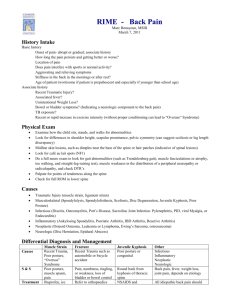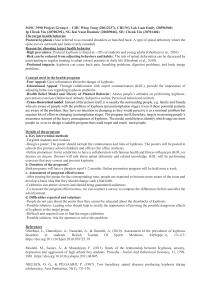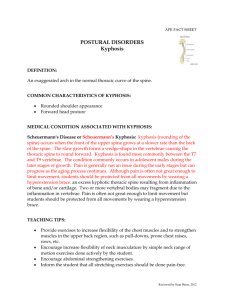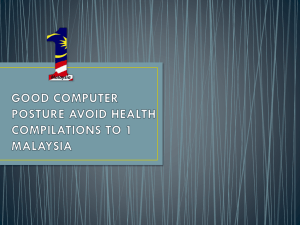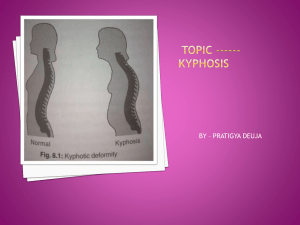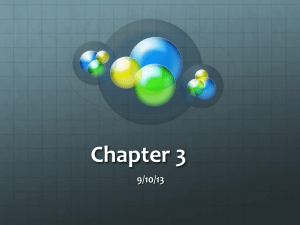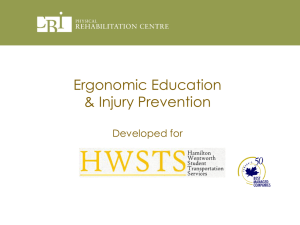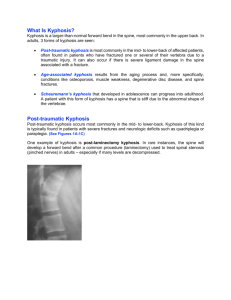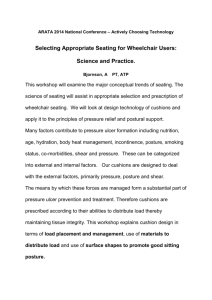Flexicurve spinal measurement - Geriatric Assessment Tool Kit
advertisement
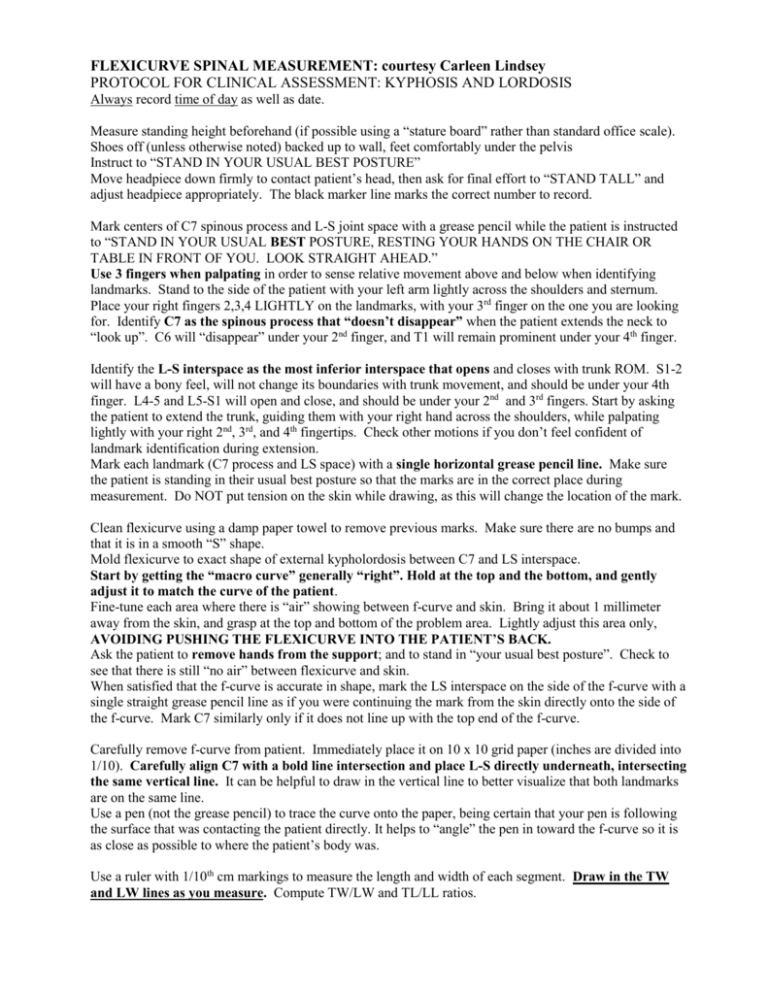
FLEXICURVE SPINAL MEASUREMENT: courtesy Carleen Lindsey PROTOCOL FOR CLINICAL ASSESSMENT: KYPHOSIS AND LORDOSIS Always record time of day as well as date. Measure standing height beforehand (if possible using a “stature board” rather than standard office scale). Shoes off (unless otherwise noted) backed up to wall, feet comfortably under the pelvis Instruct to “STAND IN YOUR USUAL BEST POSTURE” Move headpiece down firmly to contact patient’s head, then ask for final effort to “STAND TALL” and adjust headpiece appropriately. The black marker line marks the correct number to record. Mark centers of C7 spinous process and L-S joint space with a grease pencil while the patient is instructed to “STAND IN YOUR USUAL BEST POSTURE, RESTING YOUR HANDS ON THE CHAIR OR TABLE IN FRONT OF YOU. LOOK STRAIGHT AHEAD.” Use 3 fingers when palpating in order to sense relative movement above and below when identifying landmarks. Stand to the side of the patient with your left arm lightly across the shoulders and sternum. Place your right fingers 2,3,4 LIGHTLY on the landmarks, with your 3rd finger on the one you are looking for. Identify C7 as the spinous process that “doesn’t disappear” when the patient extends the neck to “look up”. C6 will “disappear” under your 2nd finger, and T1 will remain prominent under your 4th finger. Identify the L-S interspace as the most inferior interspace that opens and closes with trunk ROM. S1-2 will have a bony feel, will not change its boundaries with trunk movement, and should be under your 4th finger. L4-5 and L5-S1 will open and close, and should be under your 2nd and 3rd fingers. Start by asking the patient to extend the trunk, guiding them with your right hand across the shoulders, while palpating lightly with your right 2nd, 3rd, and 4th fingertips. Check other motions if you don’t feel confident of landmark identification during extension. Mark each landmark (C7 process and LS space) with a single horizontal grease pencil line. Make sure the patient is standing in their usual best posture so that the marks are in the correct place during measurement. Do NOT put tension on the skin while drawing, as this will change the location of the mark. Clean flexicurve using a damp paper towel to remove previous marks. Make sure there are no bumps and that it is in a smooth “S” shape. Mold flexicurve to exact shape of external kypholordosis between C7 and LS interspace. Start by getting the “macro curve” generally “right”. Hold at the top and the bottom, and gently adjust it to match the curve of the patient. Fine-tune each area where there is “air” showing between f-curve and skin. Bring it about 1 millimeter away from the skin, and grasp at the top and bottom of the problem area. Lightly adjust this area only, AVOIDING PUSHING THE FLEXICURVE INTO THE PATIENT’S BACK. Ask the patient to remove hands from the support; and to stand in “your usual best posture”. Check to see that there is still “no air” between flexicurve and skin. When satisfied that the f-curve is accurate in shape, mark the LS interspace on the side of the f-curve with a single straight grease pencil line as if you were continuing the mark from the skin directly onto the side of the f-curve. Mark C7 similarly only if it does not line up with the top end of the f-curve. Carefully remove f-curve from patient. Immediately place it on 10 x 10 grid paper (inches are divided into 1/10). Carefully align C7 with a bold line intersection and place L-S directly underneath, intersecting the same vertical line. It can be helpful to draw in the vertical line to better visualize that both landmarks are on the same line. Use a pen (not the grease pencil) to trace the curve onto the paper, being certain that your pen is following the surface that was contacting the patient directly. It helps to “angle” the pen in toward the f-curve so it is as close as possible to where the patient’s body was. Use a ruler with 1/10th cm markings to measure the length and width of each segment. Draw in the TW and LW lines as you measure. Compute TW/LW and TL/LL ratios. Kypholordosis variations: Be sure to record patient name, ID number, time and date, shoe status, and whether the test was done in “Best usual”, “Cued ideal” or another posture condition on the grid paper as well as in the chart. Index of Kyphosis* = (TW/TL)x100 Age 20-24 25-29 30-34 35-39 40-44 45-49 50-54 55-59 60-64 65-69 70-74 75-79 80 + Female 7.0 + 2.0 8.5 + 2.5 7.0 + 1.0 7.5 + 2.0 7.0 + 1.5 7.0 + 2.0 9.0 + 3.0 9.5 + 2.5 11.0 + 2.0 12.0 + 2.5 12.5 + 3.0 13.5 + 4.0 15.0 + 6.0 Male 8.5 + 2.0 8.0 + 2.5 8.0 + 2.5 8.2 + 1.5 8.5 + 2.5 8.5 + 2.5 7.5 + 2.0 8.5 + 3.0 10.0 + 3.0 11.0 + 3.0 11.5 + 2.5 12.0 + 4.0 12.0 + 4.0 * Milne JS, Lauder IJ (1974) Age Effects in Kyphosis and Lordosis Annals of Human Biology 1:327-337 References: Chow RK, Harrison JE. (1987). Relationship of kyphosis to physical fitness and bone mass on postmenopausal women. Am J Phys Med Rehaibil, 66(219-227). Crawford HJ, Jull GA. (1993). The influence of thoracic posture and movement on range of arm elevation. Physiotherapy Theory and Practice, 9, 143-148. Cutler WB, Friedmann E, Genovese-Stone E. (1993). Prevalence of kyphosis in a healthy sample of pre- and postmenopausal women. Am J Phys Med Rehaibil, 72, 219-225. Ensrud KE, Black DM, Harris F. (1997). Correlates of kyphosis in older women. JAGS, 45, 682-687. Lindsey C, Reisine S, Fertig J. (1995). Evaluation for the effects of exercise on posture, back strength, pain & mood in postmenopausal women with osteoporosis & back pain. Paper presented at the WCPT, Washington, DC. Lindsey C, Rizzo A. (1998). Posture and balance issues for the patient with osteoporosis. In Avers D (Ed.), Orthopaedic Physical Therapy Clinics of North America Osteoporosis (Vol. 7, pp. 211-234): WB Saunders Co. Lundon KM, Li AM, Bibershtein S. (1988). Interrater and intrarater reliability in the measurement of kyphosis in postmenopausal women with osteoporosis. Spine, 23(18), 1978-1985. Milne JS, Williamson J. (1983). A longitudinal study of kyphosis in older people. Age Ageing, 12, 225-233. Ryan SD, Fried LP. (1997). The impact of kyphosis on daily functioning. JAGS, 45, 1479-1486.
